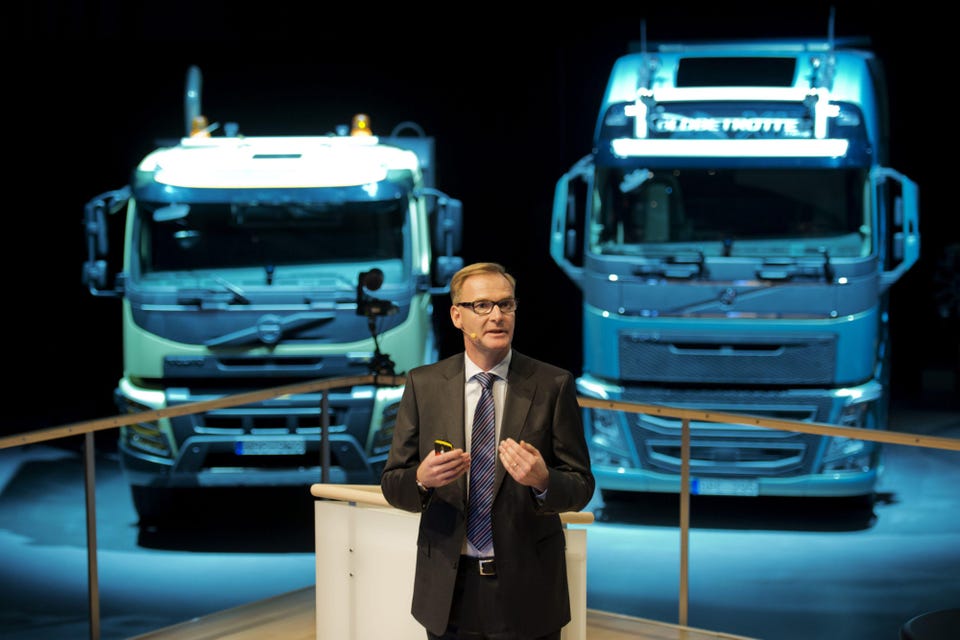Forbes Innovation Transportation European Proposals To Slash Truck CO2 Emissions By 90% Slammed As Alarming Michael Taylor Contributor Opinions expressed by Forbes Contributors are their own. Long experienced in auto journalism, Taylor is based in Italy. Following Feb 14, 2023, 10:52am EST | Press play to listen to this article! Got it! Share to Facebook Share to Twitter Share to Linkedin Volvo AB CEO Olof Persson in front of his company’s heavy trucks.
The European Commission today . . .
[+] proposed a 90% reduction in truck and bus CO2 by 2045. Photographer: Erik Abel/Bloomberg Copyright 2013 Bloomberg Finance LP European Commission proposals to slash new truck and bus emissions by 90% by 2040 have been slammed as “alarming” by Europe’s truck and bus manufacturing industry. Lead by Volvo Group CEO Martin Lundstedt, the European Automobile Manufacturers’ Association (ACEA) has called the proposal, released today, as “highly ambitious”.
He said the industry was very concerned that the proposed legislation put the onus all on the truck and bus manufacturers, with none of it on those in charge of delivering the infrastructure to recharge them or refill them. “We are ready to deliver,” Lundstedt, who also serves as the ACEA’s Commercial Vehicle Board Chairman, said. “However, reaching -45% already by 2030 is highly ambitious.
It would require equally ambitious action by policy makers to ensure that the other players in the transport and logistics value chain deliver at the same time. “While other world regions are incentivizing their way towards zero-emission mobility, Europe is trying to regulate its way – and even that is not being done in a harmonized way,” Lundstedt said. Volvo Group CEO Martin Lundstedt slammed the European Commission proposals as “alarming”, running .
. . [+] counter to EU7 agreements made just months ago, and putting all the potential penalties on vehicle makers, not those in charge of supplying charging infrastructure.
Photo: Volvo Volvo AB MORE FOR YOU The Inside Story Of Papa John’s Toxic Culture Passport Breach Hits Over 500 Cricket Stars, From Wasim Akram To Ian Bell The Danger Of Safety Campaigns Lundstedt insisted that the trucks and buses could be built to meet the proposed regulations, but no country in Europe had the infrastructure necessary to charge or refuel them, and that costs for drivers and operators must be at least revenue neutral, or they are doomed to fail. He also said he was “alarmed” that there seemed to be no coordination between the new proposals, announced today, and the EU7 targets agreed to late last year. The European Commission had targets set in 2019, pushing new trucks and buses to reduce CO2 emissions by 15 % by 2025, and by 30% in 2030.
Those targets have been slashed to arrive at today’s proposals, to a 90% reduction compared to 2019’s standards, while the EC wants all the continent’s new vehicles to be CO2 neutral by 2050. The proposed interim targets now look set at a 45% reduction by 2030 (a 50% increase in the reduction size, despite all parties agreeing to 30% just three years ago) and a 65% reduction by 2035. “In 2050, almost all vehicles on our roads must be emission-free,” said the European Commission’s Climate Commissioner, Frans Timmermans.
In a statement, he also insisted that no vehicle will be able to emit carbon that can’t be recaptured by 2050. The EC’s proposals will now be discussed, negotiated with EU member states, and put before the European Parliament before they become law. Germany’s auto industry peak body, the VDA, criticized the proposals as unworkable under current infrastructure proposals, and that view was backed by the ACEA.
To meet the 45% reduction by 2030, the ACEA insisted European customers would need to be convinced to buy 400,000 more zero-emission trucks, with at least 100,000 new zero-emission trucks registered every year. To charge them, Lundstedt said the continent would need more than 50,000 publicly accessible chargers in seven years, and 35,000 of those would need to be megawatt charging high-speed chargers, along with at least 700 hydrogen filling stations. “Given that charging stations that are suited to the specific needs of trucks are almost completely missing today, the challenge ahead is enormous,” said ACEA’s Director General Sigrid de Vries said.
“We are concerned that only vehicle manufacturers will face high penalties if other stakeholders do not fulfil their role in making this possible – especially given the low level of ambition that members states are showing on the Alternative Fuels Infrastructure Regulation (AFIR). ” Lundstedt also insisted transport operators needed assistance to run zero-emission vehicles more profitably than traditional diesels. “If this does not happen rapidly, operators won’t buy our vehicles, and as a result we will simply not be able to meet the CO2 targets,” Lundstedt said.
“At the end of the day, vehicle technology – be it battery-electric, fuel-cell electric or hydrogen-powered trucks – is only one part of the solution. To succeed with this transition of our industry, we urgently need coherent, joined-up policies. ” Follow me on Twitter .
Check out my website . Michael Taylor Editorial Standards Print Reprints & Permissions.
From: forbes
URL: https://www.forbes.com/sites/michaeltaylor/2023/02/14/european-proposals-to-slash-truck-co2-emissions-by-90-slammed-as-alarming/



